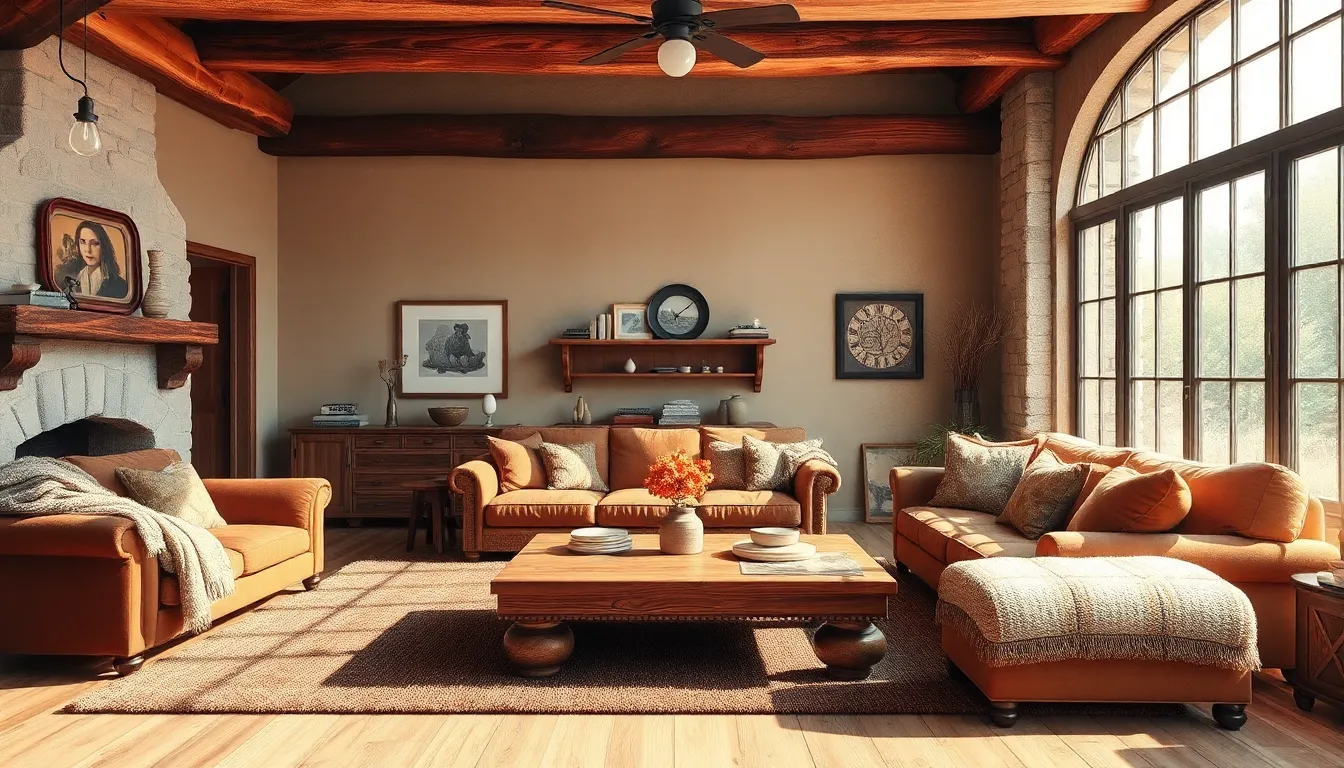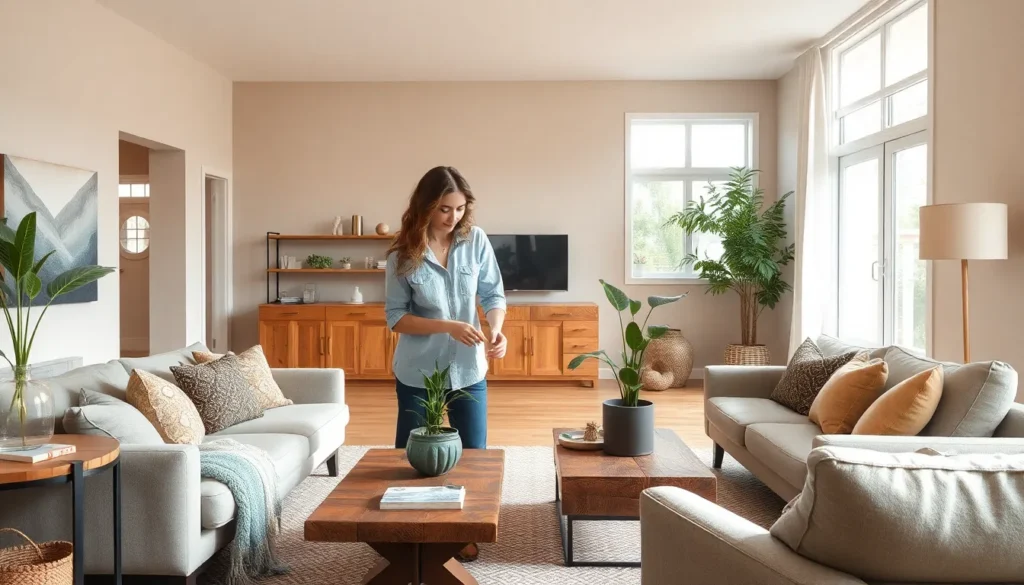Home is where the heart is, but let’s be honest—it’s also where the Instagram likes are. As trends come and go faster than a cat video goes viral, staying ahead in home design can feel like trying to catch a greased pig at a county fair. Luckily, it doesn’t have to be that complicated.
From cozy nooks that scream “Netflix and chill” to bold statement pieces that say “I’m fabulous,” today’s home trends are all about balancing comfort with creativity. Whether you’re a design novice or a seasoned pro, embracing these trends can transform any space into a sanctuary that reflects personality and style. So grab a cup of coffee, kick back, and let’s dive into the latest home design trends that’ll make your space the envy of the neighborhood.
Home Trends and Design
Evolving home trends prioritize comfort and creativity, transforming spaces into personalized sanctuaries that cater to individual preferences. Minimalism continues to be popular, emphasizing simplicity through clean lines and uncluttered spaces. Biophilic design, which incorporates natural elements, enhances indoor environments while promoting well-being.
Sustainability takes center stage, encouraging the use of eco-friendly materials and energy-efficient solutions. Homeowners opt for reclaimed wood, recycled materials, and low VOC paints to reduce their environmental impact. Smart home technology gains traction, offering convenience and efficiency through interconnected devices that streamline daily life.
Color schemes in home design reflect current trends, with muted tones and earth colors creating calming atmospheres. Soft greens, warm browns, and cream shades align with the desire for tranquility. Textures also play a vital role; mixing materials like wood, metal, and textiles adds depth and warmth to interiors.
Open floor plans retain their appeal, facilitating better flow between spaces. Integrating multifunctional furniture caters to diverse needs, especially in smaller homes. Outdoor living spaces gain importance, with homeowners embracing patios, decks, and gardens as extensions of their indoor environments.
Artisanal craftsmanship captures attention, showcasing unique pieces that convey a sense of personality. Statement lighting fixtures serve as focal points, providing both illumination and artistic flair. Home trends continue to evolve, blending style with functionality to create inviting environments that reflect individual tastes and lifestyles.
Popular Design Styles

Home design styles vary widely, reflecting individual preferences and trends. Understanding these styles helps homeowners create spaces that truly resonate with their lifestyles.
Modern Minimalism
Modern minimalism emphasizes simplicity and functionality. Spaces often feature clean lines, neutral color schemes, and a lack of clutter. Furniture choices focus on form and purpose, ensuring each piece contributes to the overall aesthetic. Natural light plays a significant role in enhancing this style, creating an airy atmosphere. Accessories are limited, allowing statement pieces to shine without overwhelming the space. This style promotes a serene environment, ideal for those seeking tranquility in their homes.
Rustic Charm
Rustic charm brings warmth and coziness into home design. Natural materials like wood and stone dominate this aesthetic, often salvaged or repurposed for added character. Earthy color palettes enhance the inviting vibe, while handcrafted elements showcase artisanal craftsmanship. Spaces frequently incorporate vintage furniture pieces that tell a story. Textiles such as wool and linen contribute to comfort and richness in these environments. This style’s focus on nature and tradition creates a sense of nostalgia and connection to the outdoors.
Industrial Aesthetics
Industrial aesthetics draw inspiration from repurposed warehouses and factories. Exposed brick, metal accents, and raw materials define this trend, giving spaces a rugged yet stylish look. Open layouts maximize natural light, often featuring large windows that enhance the overall design. Furniture tends to be sturdy and utilitarian, reinforcing a no-frills approach. The incorporation of vintage elements adds charm, bridging the past and present. These spaces evoke a sense of urban sophistication, appealing to those who appreciate modern design with historical roots.
Color Palettes for 2023
Color palettes set the tone for home design in 2023, promoting serenity and connection to nature. Homeowners increasingly gravitate toward earthy hues and muted tones, establishing calming atmospheres that inspire relaxation.
Trending Colors
Soft greens, warm terracottas, and deep blues dominate the color landscape. These shades enhance interiors by infusing spaces with a sense of grounding and tranquility. Pint-sized accents of ochre and muted pink feature prominently, adding subtle warmth without overwhelming the senses. Natural colors resonate with current preferences for minimalism and sustainability, reflecting an appreciation for organic elements.
Effective Color Combinations
Pairing colors effectively enhances visual interest. Combining sage green with soft cream creates a harmonious balance that exudes calmness. Bold blues complement warm wood tones, providing depth and richness. For a modern touch, mix terracotta with muted blush to convey a refreshed aesthetic. Creating contrast through unexpected pairings, like deep navy with light grey, invigorates spaces. Each combination conveys a unique vibe, allowing homeowners to personalize their environments effortlessly.
Sustainable Design Practices
Sustainable design practices gain traction as homeowners prioritize eco-conscious choices. These practices enhance aesthetics while minimizing environmental impact.
Eco-Friendly Materials
Reclaimed wood proves popular for flooring and furniture, adding character and reducing deforestation. Bamboo also gains favor due to its rapid growth and sustainability. Additionally, recycled metal and glass are commonly used in fixtures and decor, showcasing innovation and style. Organic fabrics like cotton and linen offer comfort while eliminating harmful chemicals. Homeowners increasingly select low-VOC paints that improve air quality and minimize emissions, creating healthier living environments. By integrating these materials, spaces become both visually appealing and eco-friendly.
Energy Efficiency Solutions
Energy-efficient appliances significantly lower energy consumption, making homes more sustainable. Smart thermostats allow homeowners to regulate temperatures effectively, optimizing heating and cooling. Home insulation plays a crucial role, with high-R-value materials reducing energy loss. Solar panels harness renewable energy, decreasing reliance on nonrenewable resources. Water-saving fixtures, including low-flow toilets and faucets, contribute to overall conservation efforts. Implementing these solutions builds a path toward responsible energy use, reflecting modern environmental values while enhancing comfort and utility.
Smart Home Innovations
Smart home technology continually advances, making homes more efficient and user-friendly. Innovations focus on enhancing daily life through automation and connectivity.
Home Automation Trends
Increasingly, homeowners embrace automation that simplifies routine tasks. Devices such as smart thermostats regulate temperature based on user preferences, providing comfort and energy savings. Smart lighting systems allow users to control brightness and color through voice commands or mobile apps, enhancing ambiance effortlessly. Security features, including smart locks and cameras, offer peace of mind through remote monitoring. Energy management systems optimize electricity usage, further reducing bills while promoting sustainability.
Integrating Technology with Design
Blending technology with design enriches both aesthetics and functionality. Designers incorporate sleek smart devices that seamlessly fit into various styles, ensuring connectivity without sacrificing appeal. Kitchen appliances, like smart refrigerators, not only offer LCD displays but also integrate with meal planning apps, enhancing culinary experiences. Living rooms benefit from integrated sound systems that deliver immersive audio without cluttering spaces. This strategic approach positions technology as a design element, showcasing its role in modern living environments.
Conclusion
Home design trends are all about creating spaces that reflect personal style while ensuring comfort and functionality. As homeowners embrace minimalism and sustainability, they’re transforming their living environments into serene sanctuaries. The integration of smart technology enhances convenience and efficiency, making daily life smoother.
With a focus on earthy color palettes and artisanal craftsmanship, today’s interiors are more inviting and expressive than ever. Whether it’s through multifunctional furniture or outdoor living spaces, the evolving landscape of home design continues to inspire creativity. Embracing these trends not only enhances aesthetics but also fosters a deeper connection to the environment and individual lifestyle needs.


More Stories
Custom Home Design Services: Transform Your Dream Home into Reality Today
Studio41 Home Design Showroom: Transform Your Space with Exceptional Design Inspiration
Transitional Home Design: Elevate Your Space with Timeless Style and Modern Comfort